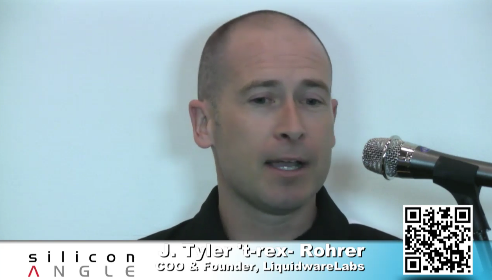 NEWS
NEWS
 NEWS
NEWS
 NEWS
NEWS
Tech innovation is everywhere these days, and that includes the previously stodgy world of consultants and integrators who in the past were associated with dark suits, conservative ![]() ties and big expensive projects. “Services innovation is happening,” declared J. Tyler “T. Rex” Rohrer, chief revenue officer and founder of Liquidware Labs, a software and services firm serving the desktop virtualization (VDI) market, at Citrix Synergy 2011 in San Francisco this week. “I come across a game-changing technology almost every week now, and service providers have to keep up with them” in order to provide value to customers, Rohrer told David Vellante, Wikibon co-founder, and John Furrier, editor and founder at SiliconAngle.com, during an appearance in the Cube.“We all need to raise our game.”
ties and big expensive projects. “Services innovation is happening,” declared J. Tyler “T. Rex” Rohrer, chief revenue officer and founder of Liquidware Labs, a software and services firm serving the desktop virtualization (VDI) market, at Citrix Synergy 2011 in San Francisco this week. “I come across a game-changing technology almost every week now, and service providers have to keep up with them” in order to provide value to customers, Rohrer told David Vellante, Wikibon co-founder, and John Furrier, editor and founder at SiliconAngle.com, during an appearance in the Cube.“We all need to raise our game.”
Liquidware, based in Alpharetta, Ga., positions itself as offering customers an “on-ramp” to VDI through a combination of services methodologies and software. The company scored a big win at Synergy this week when it received the Citrix Ready Solution of the Year award, which recognizes a company that excels in providing third-party solutions that are recommended to enhance virtualization, networking and cloud computing solutions from Citrix.
Rohrer commented that we’re living in a time of complexity and change, noting that at the desktop level, with players including Microsoft, VMware and Citrix in the mix, there are a lot of different combinations available and choices to be made. Even so, he emphasized, a good services company always has to start with a simple question for each customer: “What problem are you trying to solve?”
Liquidware helps customers plan, migrate, and manage their next-generation desktop infrastructure, and their products are VMware- and Citrix-certified. “Really, customers want to get back to the core businesses they’re engaged in, whether it’s originating loans or prosecuting lawsuits or making widgets,” Rohrer said. “We’re really engaged in a form of risk mitigation. We’re trying to provide visibility for customers as they make their technology choices.”
Regarding VDI adoption, the industry has seen three or more years of tryouts, starts and stops, but to use the baseball-game analogy, Rohrer says that the teams are just taking the field: “They’ve just played the national anthem and now the crowd is cheering, ready to start.” We’re seeing convergence in a number of areas, he noted, not the least of which is between personal technology and the stuff people work with in their jobs. “The technology people buy for personal use is actually more powerful,” he commented, so naturally there are growing expectations that the workplace will catch up. “But we’re still in a fragile stage where things like high-speed, pervasive networks aren’t 100% there yet.”
In terms of the prominence of data in the new landscape, Rohrer noted that “users only do two things: They either consume content or they create content. With all of these new flexible devices and workplace choices, we’re all creating a lot more stuff. The hope is that it’s always available, no matter where I am, with whatever device.” From a service- provider standpoint, the game today is “data-driven design” to help customers navigate the through the rapid changes the IT world is experiencing, Rohrer said.
Support our mission to keep content open and free by engaging with theCUBE community. Join theCUBE’s Alumni Trust Network, where technology leaders connect, share intelligence and create opportunities.
Founded by tech visionaries John Furrier and Dave Vellante, SiliconANGLE Media has built a dynamic ecosystem of industry-leading digital media brands that reach 15+ million elite tech professionals. Our new proprietary theCUBE AI Video Cloud is breaking ground in audience interaction, leveraging theCUBEai.com neural network to help technology companies make data-driven decisions and stay at the forefront of industry conversations.